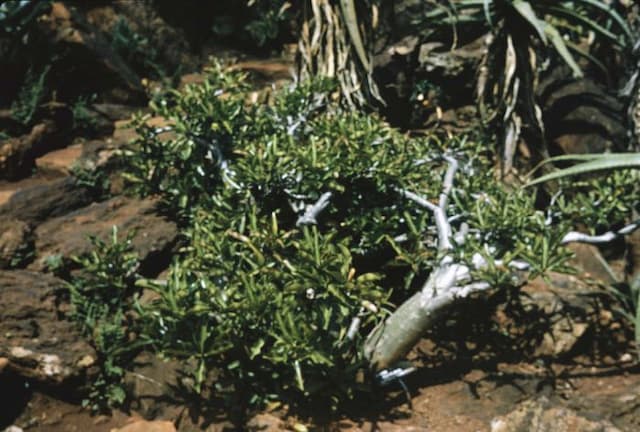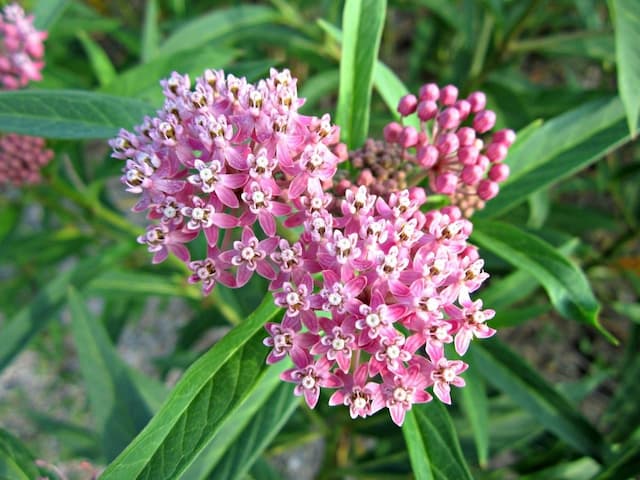Lesser Periwinkle Vinca minor 'Azurea Flore Pleno' (d)

ABOUT
Commonly known as the lesser periwinkle, the 'Azurea Flore Pleno' variant is a charming ground cover plant known for its distinctive foliage and florals. The leaves are glossy, with a deep green hue, and maintain a small, oval shape. They grow in abundance, creating a lush carpet of greenery. The true stars of the plant are its flowers. Double-flowered, they boast a rich, azure blue color and resemble miniature rosettes with their numerous petals. The blossoms typically nestle amongst the leaves, creating a striking contrast with the green backdrop. Appearing primarily during spring, the plant can continue to produce flowers sporadically throughout the summer months under favorable conditions. The plant has a trailing nature, and its stems can root at the nodes, encouraging the spread of its greenery across the ground. The overall impression is of a dense, mat-forming perennial that adds color and life to shaded areas of the garden. It's a favorite for creating an underlayer of consistent foliage and for bringing early season color with its delightful blue blooms.
About this plant
 Names
NamesFamily
Apocynaceae.
Synonyms
Lesser Periwinkle, Dwarf Periwinkle, Small Periwinkle, Common Periwinkle, Creeping Myrtle.
Common names
Vinca minor 'Azurea Flore Pleno'
 Toxicity
ToxicityTo humans
Common periwinkle is known to contain alkaloids, such as vincamine, which can be toxic if ingested. The symptoms of poisoning from common periwinkle can include nausea, vomiting, dizziness, nervous symptoms, and in severe cases, it can lead to seizures, hypertension (high blood pressure), and hypotension (low blood pressure). It is advisable for humans to avoid ingesting any part of this plant.
To pets
Common periwinkle is also toxic to pets, including dogs and cats, if ingested. The plant contains alkaloids that can cause gastrointestinal upset, such as vomiting and diarrhea. In more serious cases, ingestion can lead to depression of the central nervous system, seizures, and cardiac effects. Pet owners should prevent their animals from consuming any part of this plant.
 Characteristics
CharacteristicsLife cycle
Perennials
Foliage type
Evergreen
Color of leaves
Green
Flower color
Blue
Height
4-6 inches (10-15 cm)
Spread
1-2 feet (30-60 cm)
Plant type
Creeper
Hardiness zones
4-9
Native area
Europe
Benefits
 General Benefits
General Benefits- Ornamental appeal: Adds aesthetic value with its double blue flowers and evergreen foliage.
- Low maintenance: Requires minimal care once established, making it convenient for busy gardeners.
- Ground cover: Spreads to cover bare spots, reducing soil erosion and suppressing weed growth.
- Shade tolerance: Thrives in shady areas where other plants might struggle, offering landscaping versatility.
- Drought resilience: Once established, it can tolerate periods of dryness, reducing the need for frequent watering.
- Deer resistance: Generally not preferred by deer, which helps prevent damage to the plant and garden.
 Medical Properties
Medical Properties- Alkaloids: Vinca minor contains alkaloids such as vincamine, which has been used in the management of cerebrovascular disorders and cognitive decline.
- Vincamine: Extracted from the plant, it has been used to enhance cerebral blood flow and oxygenation to the brain, although its efficacy requires further research and should not be taken without medical supervision.
- Anti-inflammatory: There are indications that components within Vinca minor exhibit anti-inflammatory effects, potentially useful for certain conditions involving inflammation.
 Air-purifying Qualities
Air-purifying QualitiesThis plant is not specifically known for air purifying qualities.
 Other Uses
Other Uses- Ground Cover: Periwinkle is an excellent ground cover for shady areas where grass might struggle to grow, effectively suppressing weeds while providing a lush green carpet.
- Erosion Control: Its dense growth habit helps stabilize soil and prevent erosion on slopes and banks.
- Alleyways & Paved Areas: Can be planted to green-up and brighten urban spaces with hardy ground vegetation that requires minimal maintenance.
- Mosaiculture: Periwinkle's flowers and foliage can be used in mosaiculture, the horticultural art of creating living sculptures from plants.
- Landscape Borders: Ideal for edging pathways or flower beds, providing a neat border that defines landscaping features.
- Containers & Hanging Baskets: When planted in containers or hanging baskets, periwinkle drapes beautifully and adds cascades of green and purple-blue flowers.
- Fairy & Miniature Gardens: The small scale of periwinkle suits it for use in fairy gardens where it can represent lawns or woodland ground cover.
- Cemetery Plantings: Due to its low maintenance and evergreen nature, it is often used to cover graves in lieu of more traditional, high-maintenance flowers.
- Garden Artwork Backdrops: The dense foliage and flowers of periwinkle can be used as a contrasting backdrop for garden art, ornaments, or sculptures.
- Livestock Forage: While not a common use, in some rural areas goats and other livestock may graze on periwinkle as a supplemental forage when other food sources are scarce.
Interesting Facts
 Feng Shui
Feng ShuiThe common periwinkle is not used in Feng Shui practice.
 Zodiac Sign Compitability
Zodiac Sign CompitabilityThe common periwinkle is not used in astrology practice.
 Plant Symbolism
Plant Symbolism- Perseverance - The plant's ability to grow in shade and spread rapidly can symbolize one's capacity to thrive despite challenging conditions.
- Memories - Often found in graveyards and memorial gardens, the plant may represent the persistent nature of memories.
- Eternity - Given its evergreen nature, periwinkle may symbolize everlasting life or eternal affection.
- Renewal - As a plant that can regenerate after trauma, periwinkle can stand for rebirth or the start of a new chapter.
 Water
WaterPeriwinkle should be watered thoroughly once every week, allowing the top inch of the soil to dry out between waterings. During hot, dry periods, increase the frequency to twice per week. When you water, aim for about one gallon per plant each time, focusing the water at the base to avoid wetting the foliage, which can promote disease. Avoid overwatering as Periwinkle prefers well-drained soil and doesn’t tolerate waterlogged conditions well.
 Light
LightPeriwinkle thrives best in partial shade to full shade. It is tolerant of a range of light conditions but should be protected from intense, direct sunlight to prevent scorching. An ideal spot for Periwinkle would be under a tree canopy or on the north side of a building where it can receive dappled sunlight throughout the day.
 Temperature
TemperaturePeriwinkle is hardy and can withstand a range of temperatures, ideally thriving in conditions between 60°F and 80°F. It can survive minimum temperatures down to about -30°F and maximum temperatures up to about 90°F. Periwinkle does well in typical outdoor conditions in most temperate climates without the need for additional temperature control.
 Pruning
PruningPeriwinkle should be pruned to control its spread, remove dead or damaged growth, and encourage bushier growth. The best time to prune Periwinkle is in early spring, just before new growth begins. Cut back stems that are too long or have become bare to maintain the plant's shape and size. Pruning can be done annually or as needed to keep the planting area tidy and to prevent Periwinkle from encroaching on other plants.
 Cleaning
CleaningAs needed
 Soil
SoilFor Common Periwinkle, prepare a well-draining soil mix with peat, loam, and perlite or sand in equal parts; it thrives in a pH range of 6.0-7.5.
 Repotting
RepottingCommon Periwinkle is a ground cover and typically does not require repotting; it spreads by rooting stems.
 Humidity & Misting
Humidity & MistingCommon Periwinkle is adaptable and does not require specific humidity levels, thriving in average outdoor conditions.
 Suitable locations
Suitable locationsIndoor
Place in bright, indirect light and water when topsoil is dry.
Outdoor
Plant in partial shade, well-draining soil, and water moderately.
Hardiness zone
4-9 USDA.
 Life cycle
Life cycleVinca minor 'Azurea Flore Pleno', commonly known as Dwarf Periwinkle, begins its life cycle as a seed, which upon germination, sends out a small shoot and root system. As a perennial, it quickly establishes itself, developing a network of stems and leaves, and in the right conditions it can spread to form a dense mat by vegetative propagation through rooting at the nodes. The growth phase continues with the plant producing distinctive double blue flowers primarily in spring and continuing sporadically through fall, attracting pollinators and sometimes self-seeding if conditions allow. Following pollination, the flowers develop into fruit, which are not typically showy but contain seeds that can contribute to new plant growth. The plant enters a period of dormancy during colder months, although in milder climates the leaves may remain evergreen, conserving energy for the next growing season. Throughout its lifecycle, Dwarf Periwinkle can continue to spread and thrive in its environment, often for several years, requiring little maintenance once established.
 Propogation
PropogationPropogation time
Spring-Early Summer
Commonly known as Dwarf Periwinkle, Vinca minor 'Azurea Flore Pleno' is typically propagated by cuttings. The most popular method involves selecting healthy, non-flowering stems from the plant during the spring or early summer when the plant's growth is most vigorous. Cut a 4 to 6-inch (about 10 to 15 centimeters) length of stem, making sure that it includes at least two sets of leaves. Remove the leaves from the lower half of the cutting to expose the nodes where roots will form. The stem cuttings can then be dipped in rooting hormone powder to encourage root development and planted in a mixture of perlite and peat or any well-draining potting mix. The cuttings should be kept moist and in a warm environment with indirect light. Roots typically develop within a few weeks, after which the new plants can be transplanted into the garden or into individual pots.









